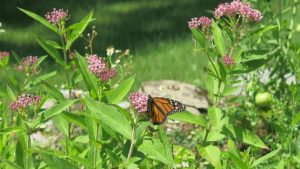“They are perhaps Earth’s most unsung heroes: the bees, butterflies, wasps, flies, and other organisms that maintain balanced ecosystems and thus the health of our food supply through pollination. Native insects, in fact, play a crucial role in pollinating and fertilizing up to 75 percent of plant species on earth, and up to a third of our staple food crops rely upon insects alone to disperse their pollen and fertilize their fruits. Imagine a world without coffee, chocolate, apples, and many other foods that are part of our daily lives. That world likely becomes reality without pollinators.” A Guide to Pollinators at Seedsavers.org
The bad news is that pollinators, so important to biological diversity and our food supply, are threatened worldwide. The good news is that individuals can play an important role in protecting pollinators. It is simple, rewarding, and important.
- Grow a variety of pollinator-friendly flowers that bloom from spring through fall.
- Don’t forget to plant caterpillar host plants. including dill, parsley, Queen Anne’s lace, milkweeds, asters, ironweed and mallows. There are many lists online.
- Avoid using pesticides, especially insecticides.
- Consider adding a nest for native bees to your garden.

What to grow:
See the Living Green in Needham list of recommended garden plants
MonarchWatch.org has a list of plants for butterfly and pollinator gardens in the Northeaster United States.
Register your Yard:
Become part of the Pollinator Pathway.
Take the Pollinator Protection Pledge from the Xerces Society.
Removing Invasive Plants:
Invasive plants are not only a nuisance — they crowd out native plants and can interfere with wildlife. Perhaps you noticed in your yard a pesky vine that grows on fences, and twists around shrubs and perennials, developing long green pods that produce wind-borne seeds. This is a swallow-wort, which is related to milkweed and may interfere with monarch butterfly reproduction.
Check out Mass Audubon’s list of common Massachusetts invasives.
Local invasive plants include glossy buckthorn (grows as a deciduous shrub or a small tree up to 20 feet tall), garlic mustard, Japanese knotweed (heart-shaped leaves and white flowers, forms dense stands that crowd out other plants), and black swallow-wort (vine with narrow seed pods similar to milkweed).
Updated August 2023.
Resources
Documents
Resources on the Web
|
Grow Native Massachusetts
Grow Native Massachusetts | |
|
Grow Native Massachusetts - Our Experts' Videos
Watch Grow Native Massachusetts "Evenings with Experts" Recorded Lectures |

